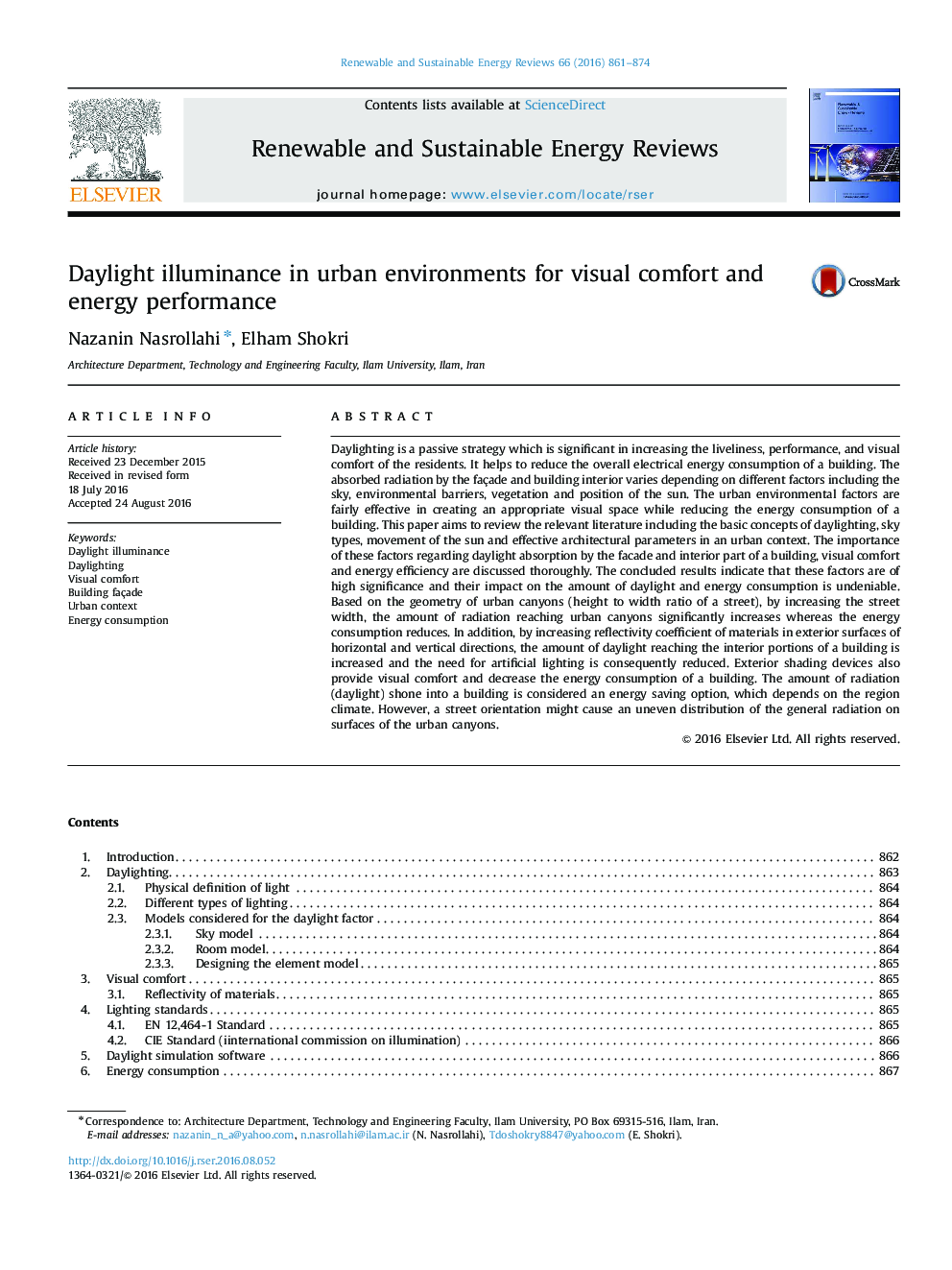| کد مقاله | کد نشریه | سال انتشار | مقاله انگلیسی | نسخه تمام متن |
|---|---|---|---|---|
| 8112862 | 1522319 | 2016 | 14 صفحه PDF | دانلود رایگان |
عنوان انگلیسی مقاله ISI
Daylight illuminance in urban environments for visual comfort and energy performance
ترجمه فارسی عنوان
روشنایی در فضای باز در محیط های شهری برای راحتی بصری و عملکرد انرژی
دانلود مقاله + سفارش ترجمه
دانلود مقاله ISI انگلیسی
رایگان برای ایرانیان
کلمات کلیدی
روشنایی روز نور، نور روز آسایش بصری، ساختمان فاگاد، زمینه شهری، مصرف انرژی،
ترجمه چکیده
نور روز، یک استراتژی منفعل است که در افزایش حیات، عملکرد و آسایش بصری ساکنان قابل توجه است. این کمک می کند تا به طور کلی مصرف انرژی الکتریکی یک ساختمان را کاهش دهد. اشعه جذب شده توسط فضای داخلی ساختمان و داخلی بسته به عوامل مختلف از قبیل آسمان، موانع محیطی، پوشش گیاهی و موقعیت خورشید متفاوت است. عوامل محیطی شهری در ایجاد یک فضای بصری مناسب در حین کاهش مصرف انرژی یک ساختمان نسبتا موثر هستند. این مقاله به بررسی ادبیات مربوطه از جمله مفاهیم پایه ای از نور روز، انواع آسمان، حرکت خورشید و پارامترهای معماری موثر در یک زمینه شهری می پردازد. اهمیت این عوامل در جذب نور روز توسط نمای داخلی و داخلی ساختمان، راحتی بصری و کارایی انرژی به طور کامل مورد بحث قرار می گیرد. نتایج به دست آمده نشان می دهد که این عوامل از اهمیت بالایی برخوردار هستند و تأثیر آنها بر میزان نور روز و مصرف انرژی غیرقابل انکار است. بر اساس هندسه کانی های شهری (نسبت ارتفاع به عرض یک خیابان)، با افزایش عرض خیابان، میزان اشعه رسیدن به کانون های شهری به میزان قابل توجهی افزایش می یابد در حالی که مصرف انرژی کاهش می یابد. علاوه بر این، با افزایش ضریب بازتابی مواد در سطوح بیرونی جهت افقی و عمودی، مقدار نور روز به بخش داخلی ساختمان افزوده می شود و نیاز به روشنایی مصنوعی در نتیجه کاهش می یابد. دستگاه های سایه بیرونی نیز راحتی بصری را فراهم می کنند و مصرف انرژی یک ساختمان را کاهش می دهند. مقدار تابش (نور روز) به یک ساختمان درخشیده است، گزینه ای برای صرفه جویی در انرژی محسوب می شود که بستگی به محیط زیست منطقه دارد. با این حال، جهت گیری خیابانی ممکن است توزیع ناهموار تابش عمومی را در سطوح کانون های شهری ایجاد کند.
موضوعات مرتبط
مهندسی و علوم پایه
مهندسی انرژی
انرژی های تجدید پذیر، توسعه پایدار و محیط زیست
چکیده انگلیسی
Daylighting is a passive strategy which is significant in increasing the liveliness, performance, and visual comfort of the residents. It helps to reduce the overall electrical energy consumption of a building. The absorbed radiation by the façade and building interior varies depending on different factors including the sky, environmental barriers, vegetation and position of the sun. The urban environmental factors are fairly effective in creating an appropriate visual space while reducing the energy consumption of a building. This paper aims to review the relevant literature including the basic concepts of daylighting, sky types, movement of the sun and effective architectural parameters in an urban context. The importance of these factors regarding daylight absorption by the facade and interior part of a building, visual comfort and energy efficiency are discussed thoroughly. The concluded results indicate that these factors are of high significance and their impact on the amount of daylight and energy consumption is undeniable. Based on the geometry of urban canyons (height to width ratio of a street), by increasing the street width, the amount of radiation reaching urban canyons significantly increases whereas the energy consumption reduces. In addition, by increasing reflectivity coefficient of materials in exterior surfaces of horizontal and vertical directions, the amount of daylight reaching the interior portions of a building is increased and the need for artificial lighting is consequently reduced. Exterior shading devices also provide visual comfort and decrease the energy consumption of a building. The amount of radiation (daylight) shone into a building is considered an energy saving option, which depends on the region climate. However, a street orientation might cause an uneven distribution of the general radiation on surfaces of the urban canyons.
ناشر
Database: Elsevier - ScienceDirect (ساینس دایرکت)
Journal: Renewable and Sustainable Energy Reviews - Volume 66, December 2016, Pages 861-874
Journal: Renewable and Sustainable Energy Reviews - Volume 66, December 2016, Pages 861-874
نویسندگان
Nazanin Nasrollahi, Elham Shokri,
